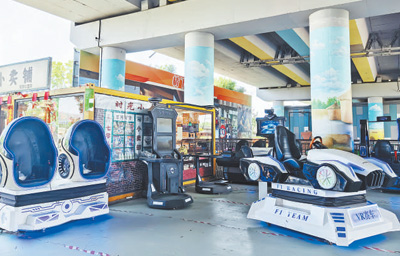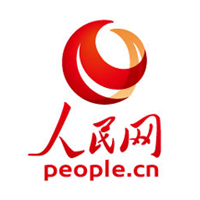 |
"Paradise under Paddy Bridge" in Paddy Park, Jinyuan District, Taiyuan City, Shanxi Province.
Information picture |
With the rapid development of the city, viaducts have emerged to connect various regions and relieve traffic pressure. At the same time, the space under the bridge has become the main site for bus stations, sanitation storage and temporary parking, and some of it is used for greening or idle. This kind of utilization mainly depends on cars rather than people. Focusing on this phenomenon, in recent years, government departments, designers, experts and scholars and other parties have paid more attention to how to use innovative design to make "another hole" under the bridge. Beijing, Shanghai, Shenzhen and other places have successively introduced measures on the utilization, design and management of space under the bridge, expanded the idea of improving the function and quality of space under the bridge, and promoted the completion of a number of upgrading and transformation of space under the bridge. The space under the bridge, which has never been noticed before, is being organically renewed to become a beautiful space with aesthetic, humanistic and ecological characteristics.
From "breakpoint" to "anchor point", optimize traffic by designing "knitting stitching". Urban viaducts are often complicated, which are easy to cause problems such as difficulty for pedestrians to cross the street and slow transfer and connection. They are the "breakpoints" in the minds of residents. How to connect "breakpoints" and make them bright? In the renovation of the space under the Tianning Temple Bridge in Xicheng District of Beijing, the design team planned it as a whole with the surrounding space, and created a safe and convenient slow traffic system by means of ground signs, color pavement differentiation, signs and other means, making it an effective way to repair the functions of the old city and reshape the urban texture. In the five townships of Yinzhou District, Ningbo City, the abandoned ground section of Beilun Branch of Xiaoyong Railway, Metro Line 1 and Xiaoyong Railway Elevated Section form three east-west parallel linear spaces. The fragmentation between them makes it difficult to release the travel demand of residents. In order to solve this problem, the design team plans to build the 987 High Line Park, connecting the north and south spaces, and connecting the road network breakpoints between the alleys and the site to meet the travel and leisure needs of the public. In some places, the safety and accessibility of the space under the bridge are increased by virtue of the streamline design of the pedestrian and vehicle branches. In these renovation projects, the design team "weaves" the area and "stitches" the city by multiple means to rebuild the spatial connection and lay a solid foundation for activating the space under the bridge.
From "public" to "public", promote the functional upgrading and composite utilization of space under the bridge. The space under the bridge seems to be a "public area" unrelated to residents, but if fully utilized, it can also become a shared space for residents' leisure and communication. In the renovation of the space under the Central Bridge in Changning District, Shanghai, the design team designed the three separate spaces under the bridge as a whole, releasing more composite service spaces for leisure and parking, including waterfront promenades, children's playgrounds, service stations, etc., making the once uninhabited area a favorite public space for residents. Under the Panhuo Viaduct in Ningbo, the birth of a sports park also shows the great potential of the space under the bridge. Panhuo Sports Park was originally a wasteland with piles of muck. During the transformation, the design team positioned it as a multi-functional sports park integrating national fitness, culture and leisure, and set up badminton halls, basketball halls and other venues, providing a comfortable place for the surrounding residents to move. Facts have proved that the design of space under the bridge is flexible and diversified. When the urban "leftover materials" are fully utilized, they can also become a favorite shared space for people to improve the quality of the local environment and functions of the city while improving the quality of life of residents.
From "monochrome" to "colorful", add vitality and highlight individuality with art. The space under the urban bridge should be both functional and artistic. In the design of space under the bridge, the natural color can echo the surrounding waterfront green space, the calm color can highlight the cultural and historical heritage, and the bright color can connect the young modern life. In the renovation of the space under the bridge of Jiangsu North Road in Shanghai, the design team took the yellow gas pipe in the site as an inspiration, abstractly designed each device and structure as a symbolic pipeline shape, and continued to paint with high saturation color, which matched the project name "Suhe Super Pipe". The linear geometric texture of the pipeline and bright colors form a dramatic artistic effect, which not only strengthens the industrial sense of the site, but also echoes the industrial development history of Suzhou River. The space under the bridge full of artistic atmosphere is also the "second classroom" for carrying out children's aesthetic education. The "Butterfly Dance Pocket Park" under the Dongdang Bridge in Jiangsu Province designs the game area and recreation facilities from the perspective of children with a height of "1 meter". The pier and ground are decorated with stretch lines and bright colors, and three-dimensional recreation facilities in the shape of butterflies are set up, both with childlike charm and artistic sense. The organic integration of artistic elements and colors into the space under the bridge has become one of the important dimensions of design. How to coordinate functionality and artistry is a subject worthy of continuous exploration by designers.
From "green plants" to "green environment", create a beautified space with ecology and close to nature. Due to insufficient light and water in the space under the bridge, plants with single variety, shade and drought tolerance are often selected. Concerned about this phenomenon, some design teams divided the space under the bridge reasonably according to the lighting conditions through scientific analysis to create a rich plant community and ecological environment and make the space under the bridge full of vitality. For example, in Pengding Garden under Yongfeng Flyover in Chengdu, Sichuan Province, there are ornamental flowers all the year round, creating the artistic conception of Jiangnan Garden with winding paths, or forming a forest garden atmosphere surrounded by big trees. Flowers, trees, water and bridges together form the landscape of Taoyuan full of natural beauty. Under the Guangshen Yanjiang Expressway Bridge in Bao'an District, Shenzhen City, Guangdong Province, a bright greenway winds. This slow-moving road from Xiwan to Qianwan is partially integrated with the surrounding green space, so that people can immerse themselves in the natural gift of "mountains and seas are connected, and the city is in the scenery". With the help of ecological construction, the space under the bridge not only becomes a green channel connecting people and nature, but also adds a touch of poetry to people's beautiful life.
From "idle space" to "cultural space", the design highlights the regional cultural characteristics and continues the context. In the design of space under the bridge, "adjusting measures to local conditions" not only means that the design should be carried out in combination with its geographical location and natural environment, but also means that the humanistic heritage of the space where the bridge is located should be fully explored, and the single space under the bridge should be turned into a field that stimulates emotional resonance and condenses cultural consensus. Some designers try to integrate representative cultural symbols into the design to add a sense of history and culture to the space under the bridge. For example, the old Chengdu Folk Custom Park, located under the overpass of Renmin South Road in Chengdu, Sichuan Province, highlights the regional characteristics of the opera masks on the pillars in the park, and many art bronze statues vividly reproduce the life of the old Chengdu citizens. Some designers dig deeply into the historical and cultural resources contained in the space under the bridge to show the past and present life of the site by design means. Like the vacant land under the Egongyan Bridge in Chongqing, after the design team combed and activated this historical site, it has become the former site park of the Anti Japanese War, which centers on the museum settlement and displays historical culture. These practices have proved that, with proper design, the space under the bridge can also become a carrier for shaping the image of urban culture and highlighting the charm of urban culture.
Today's cities need not only large reception halls, but also small and beautiful spaces. The space under the bridge has various forms, and the designers face different problems. Not every space under the bridge is suitable for embedding into the activity site or service facilities, and it may not be decorated in colorful. On the premise of ensuring safety and accessibility, it is feasible to explore "one bridge, one policy" according to local conditions. The transformation is only the beginning, and the new space under the bridge needs good operation management mechanism to support, which can bring more long-term benefits.
(The author is a senior engineer of Shanghai Urban Planning and Design Institute)
People's Daily (June 16, 2024, Version 08)
(Editor in charge: Bai Yu, Wei Jia)
Share to let more people see





































